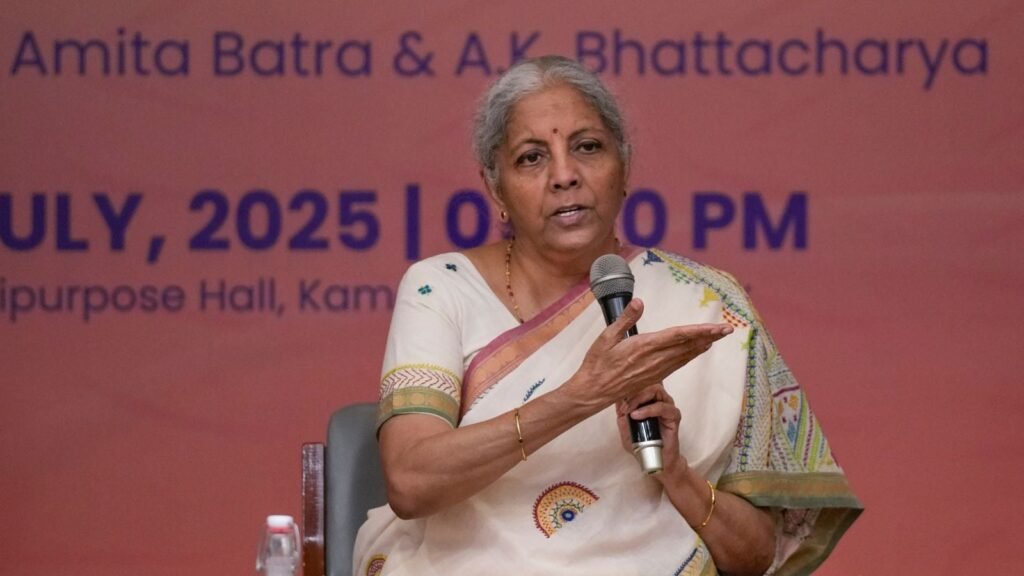India and China are beginning to move towards more access and interactions that might help the economy, even as a sense of caution would have to be built in, Finance Minister Nirmala Sitharaman said on Saturday. She also underlined that maintaining growth is India’s top priority along with the need to be a dynamic player in global institutions and redefining its role in the global South, and having a friendly and attractive FDI policy to be able to get more and more investments.
When asked about the thaw in Indo-China relations at the launch of the book A World in Flux: India’s Economic Priorities with the recent relaxation of visa norms, Sitharaman said not just India but China has also shown interest in these interactions and one will have to “wait and see” how far it will go.
Citing the restrictions earlier enlisted in Press Note 3 that had put curbs on investments from China, which also affected some of the projects including those in the renewable energy sector, Sitharaman said there was lull during the tariff war between the US and China. But, now it has been felt by both India and China for the “need to have more access and a lot more interactions that could possibly open some windows”.
“And that’s not just from our side, even the Chinese have been approaching through the MEA. So, you had External Affairs Minister S Jaishankar go. There is something, some kind of a beginning, as to how much it will take us far; how far it will go is something we will have to wait and see. But it might help the economy; however much, a sense of caution would have to be built in,” she said.
Last week, External Affairs Minister S Jaishankar travelled to China where he had underlined that “differences should not become disputes” nor should “competition ever become conflict” and that while India and China have made good progress in the past nine months towards the normalisation of bilateral relations, they should work to address de-escalation on the border.
India had earlier put restrictions on investments from China through Press Note 3 in April 2020 to curb potential opportunistic takeovers of Indian companies during the Covid-19 pandemic by making a government approval mandatory for all investments from countries sharing a land border with India, including China. It continued to be in force in the wake of national security concerns due to border tensions after the Galwan clash.
Enlisting India’s priorities, Sitharaman said growth is the topmost priority. “Growth is the topmost priority, and therefore, it will have an overlap with: do you create jobs, do you have that value addition,” she said.
Story continues below this ad
The Indian economy grew by 6.5 per cent in FY25, the slowest in four years as against 9.2 per cent growth in FY24. For the current financial year 2025-26, the Economic Survey has projected GDP growth at 6.3-6.8 per cent, while the RBI has lowered its growth forecast to 6.5 per cent from an earlier level of 6.7 per cent for FY26.
The second objective for India would be to be relevant on the global stage, she said. “Not just to be there in the leadership position but to be able to define how this move is going to take India forward along with the rest of the countries. We need to define the global institutions which are going to govern us for the next hundred years,” she said.
Within India, Sitharaman said the government will have to focus on whether it is giving the economy the necessary support and attending to every aspiring section’s aspirations, not just by giving money but by giving an overall ecosystem through which they can aspire to grow. Finding resources for meeting domestic economic aspirations within fiscal constraints is another priority for the government, she said. Another priority would be to make sure that the FDI policy is friendly and attractive to be able to get more and more investments happening in India.
On the issue of trade pacts, Sitharaman said agreements are taking priority over multilateral trade even though she can’t comment if it’s good or bad as of now. “On the bilateral trade front, we are moving forward and we have seen bilateral agreements being signed in the last four to five years with Australia, UAE, EFTA and the UK. Negotiations are progressing well with the United States as well as the European Union,” she said.

